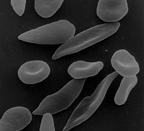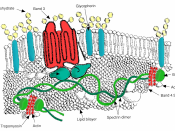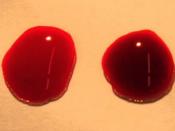Surrounded by platelets (thrombocytes), various hormones, salts, some proteins and wastes, the red blood cell (erythrocyte) which is contained in plasma, becomes oxygenated in a capillary in the left lung. From here it is forced into one of the pulmonary veins, and transported into the left atrium, a thin-walled chamber which acts as a reservoir, which then contracts, squeezing out any blood which hasn't already passed along into the left ventricle. The left ventricle is the most muscular part of the heart, and it is made up of a chamber surrounded by thick muscle walls, which create a massive amount of pressure when contracted. The flow of blood into the ventricle is controlled by the bicuspid valve, and the contraction of the ventricle is so forceful that the cells move at high pressure into the aortic arch and on into the aorta. The cell then is pumped passed the opening to the coronary artery, which protrudes from the aortic root, and into one of the iliac arteries, which branch out to the lower trunk of the body and divide, becoming the femoral and popliteal arteries of the thigh and the leg.
While in the thigh, the oxygen rich blood cell feeds the muscles with the nutrients created by the oxygen within it, and converts the contents of the cell to carbon dioxide.
The rate and pressure of the heartbeat mechanism then cause the now oxygen-depleted red blood cell to continue its circuit back to the lungs, via the heart. Carried in veins back up the leg, the de-oxygenated blood cell enters the inferior vena cava, which pressures it into the right atrium, in the right side of the heart. The cell is passed through the atrium into the right ventricle, where it is slowly released into one of...


